|
|
 |
Fiche d'espèce de Copépode |
|
|
Calanoida ( Ordre ) |
|
|
|
Clausocalanoidea ( Superfamille ) |
|
|
|
Diaixidae ( Famille ) |
|
|
|
Sensiava ( Genre ) |
|
|
| |
Sensiava secunda Markheseva, 2014 (F, ?M) | |
| | | | | | | Ref.: | | | Markhaseva, 2014 (p.218, Descr.F, M, figs.F, M, Rem: a doubt subsists concerning the male attibution) | 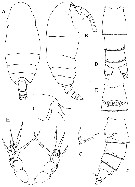 Issued from : E.L. Markhaseva in Zootaxa, 2014, 3802 (2). [p.219, Fig.1]. Female (from equatorial South Atlantic): A-B, habitus (dorsal and lateral, respectively); C, rostrum (lateral); D, urosome (dorsal); E, genital double-somite (ventral); F, urosome (lateral); G, genital field (lateral); H, P5 (posterior) Scale bars: A-B, 0.5 mm; C-H, 0.1 mm.
Nota: Prosome 3.9-3.8 as long as urosome.
Rostrum as 2 filaments.
Cephalosome and 1st pedigerous somite incompletely separate, 4th and 5th completely separate.
Posterior corners of prosome in dorsal view triangular, as short rounded lobes in lateral view.
Urosome of 4 somites.
Spermathecae of moderate size, slightly upturned anteriorly.
Caudal rami symmetrical, with 1 dorsal, 1 ventral and 4 terminal setae.
P5 3-segmented, composed of coxa, basis and 1-segmented exopod; coxa with sparse small spinules distolaterally; basis with distolateral patch of spinules; exopod ornamented with dense surface spinules, 4 distal spines partly or completely separate from segment, medial spine longest.
|
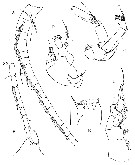 Issued from : E.L. Markhaseva in Zootaxa, 2014, 3802 (2). [p.220, Fig.2]. Female: A, A1, articulating segments 1-16 (ancestral segments I-XIX); B, A1, articularting segments 17-24 (ancestral segments XX-XXVIII); C, A2; D, Md palp; E, Md gnathobase with cutting edge; F, P1 (anterior). Scale bars: 0.1 mm. Nota: A1 nearly as long as body, or extending to caudal rami, 24-segmented. A2: coxa with 1 seta; basis with 2 setae (1 very short); exopod 7-segmented, setal formula 0, 0-0-1, 1, 1, 1, 1, 1, and 3 setae; endopod 2-segmented, setal formula 1, 8+6 setae. Md: gnathobase without crest, cutting edge with 4 large and 4 small teeth near dorsal seta; basis with 3 setae; exopod 5-segmented with 1, 1, 1, 1 and 2 setae; endopodal segment 1 with 2 setae, segment 2 with 9 setae.
|
 Issued from : E.L. Markhaseva in Zootaxa, 2014, 3802 (2). [p.221, Fig.3]. Female: A, Mx1; B, Mx1, praecoxal arthrite (posterior and anterior setae, thick short arrow marks distalmost terminal seta curved at the apex, thin long arrow marks posterior and anterior setae); C, Mx2 (brush-like setae of endopod are not figured); D, Mx2 sensory setae of endopod; E, Mxp. Scale bars: 0.1 mm. Nota: Mx1: praecoxal arthrite with 9 marginal, 4 posterior and 1 anterior setae, distalmost praecoxal arthrite terminal seta curved at apex (arrowed); coxal endite with 4 setae; coxal epipodite with 7 long and 2 short setae; proximal basal endite with 4 setae , distal basal endite with 4 setae; endopod with 9 (3+6) setae; exopod with 8 setae. Mx2: praecoxal endite (previously considered as proximal praecoxal endite) with 5 setae; coxal endite (previously considered as distal praecoxal endite) with 3 setae; basal endites (previously considered as coxal endites) with 3 setae each, 1 seta of proximal basal endite sensory, worm-like; enditic-like lobe of proximal endopodal segment (previously considered as proximal basal endite) with 4 setae, 2 sensory, worm-like; setae of the maxilla basal endites and enditic-like lobe of endopod are similar in shape and size, curved and curled distally; endopod with 3 worm-like and 5 brish-like sensory setae and 1 small sclerotized seta. Mxp: syncoxa with 1 sclerotized seta on proximal praecoxal endite, 2 sclerotized setae on middle praecoxal endite and 3 sclerotized setae, distal most with poorly developed brush on distal praecoxal endite; coxal lobe with 3 setae; basis with 3 proximal setae and 2 distal setae; endopod 5-segmented with 4, 4, 3, 3+1, and 4 setae.
|
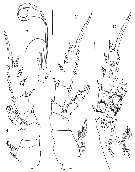 Issued from : E.L. Markhaseva in Zootaxa, 2014, 3802 (2). [p.222, Fig.4]. Female: A, Mxp, endopod segments 4 and 5; B, P2; C, P3; D, P4. Scale bars: 0.1 mm.
|
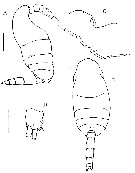 Issued from : E.L. Markhaseva in Zootaxa, 2014, 3802 (2). [p.224, Fig.5]. As Sensiava cf. secundaMale (from G. of Guinea largo sensu): A-B, habitus (lateral and dorsal, respectively); C, rostrum (lateral); D, caudal ramus (dorsal). Scale bars: A-B, 0.5 mm; C-D, 0.1 mm. Nota: Prosome 2.2-2.6 times as long as urosome. Cephalosome and pedigerous somite 1 incompletely separate, 4th and 5th completely separate. Posterior corners of prosome in dorsal view obtuse-triangular, as short rounded lobes in lateral view. Urosome with 5 somites. Caudal rami with 1 dorsal, 1 ventral and 4 terminal setae. Oral parts as in females, except for: 1- in A2 endopod segment2 with only 5+5 setae saved, other setae broken, precise setae number not observed; 2- Md basis with 2 setae (endopod damaged); 3- Mx1 with 1 of 4 coxal setae small; 4- Mx2 praecoxal endite (previously considerd as proximal praecoxal endite) with 4 setae and a small attenuation (vs additional 1 small sclerotized seta in female) and endopod with 3 worm-like and 5 brush-like sensory setae (vs additional 1 small sclerotized seta in female); 5- Mxp endopod segment 5 with 2 very long setae. Remarks: These male specimens are similar to females of S. secunda in size and share with those females a general shape of oral limbs and swimming setation, and differ from the males of S. longiseta in : 1- the shape of the geniculated A1 transformed segments XIX-XXIII; 2- presence of 4 setae on the coxal endite of Mx1 (vs. 3 setae in S. longiseta); 3- presence of a small brush at the seta of the distal praecoxal setal group of Mxp (brush absent in S. longiseta); 4- A different shape of left P5 exo- and endopods.
|
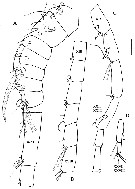 Issued from : E.L. Markhaseva in Zootaxa, 2014, 3802 (2). [p.225, Fig.6]. As Sensiava cf. secundaMale: A, right A1, articulating segments 1-9 (ancestral segments I-XII); B, same, articulating segments 10-15 (ancestral segments XIII-XVIII); C, same, articulating segments 16-21 (ancestral segments XIX-XXV); D, same, articulating segments 22-23 (ancestral segments XXVI-XXVIII). Scale bar: 0.1 mm. Nota: A1 nearly as long as body; right with 23 articulating segments, segments XIX to XXIII transformed, compared to left.. Left of 24 articulating segments.
|
 Issued from : E.L. Markhaseva in Zootaxa, 2014, 3802 (2). [p.226, Fig.7]. As Sensiava cf. secundaMale: A, left A1, articulating segments 16-19 (ancestral segments XIX-XXI); B, same, articulating segments 19-24 (ancestral segments XXII-XXVIII); D, Mxp. Scale bars: 0.1 mm.
|
 Issued from : E.L. Markhaseva in Zootaxa, 2014, 3802 (2). [p.227, Fig.8]. As Sensiava cf. secundaMale: A, P5; B, right P5, exopod segments 2-3; C, left P5, distal part of endopod; D, left P5, exopod (short thick arrows mark cavity); E, left P5, exopod and endopod (short thick arrows mark cacity). A-D, male 2.90 mm; E, male 3.00 mm. Scale bars 0.1 mm. Nota: Swimming legs as in females, except for P4 posterior surface of coxa, basis, exopod and endopod with sparse spinulation compared to females. P5 asymmetrical, with uniramous right leg (small rudiment of endopod present), and biramous left leg; coxae fused, of similar size, left basis slightly longer than right. Right leg exopod 3-segmented; segment 2 with small spine distally, segment 3 spine-like and tapering distally. Left leg with 2-segmented exopod, segment 1 with moderate medial projection and small lateral spine, segment 2 of complex structure, with cavity opening terminally surrounded by rows of spinules anteriorly and posteriorly. Left endopod 1-segmented, curved, longer than 2-segmented exopod, with terminal spine-like attenuation.
| | | | | NZ: | 1 | | |
|
Carte de distribution de Sensiava secunda par zones géographiques
|
| | | | Loc: | | | South Artlantic (G of Guinea largo sensu)
Type locality Female and Male: 00°45'S, 05°35'W. | | | | N: | 1 | | | | Lg.: | | | (1171) F: 3,30; ? M: 2,80-3,0; {F: 3,30; ? M: 2,80-3,0} | | | Dernière mise à jour : 01/02/2015 | |
|
|
 Toute utilisation de ce site pour une publication sera mentionnée avec la référence suivante : Toute utilisation de ce site pour une publication sera mentionnée avec la référence suivante :
Razouls C., Desreumaux N., Kouwenberg J. et de Bovée F., 2005-2025. - Biodiversité des Copépodes planctoniques marins (morphologie, répartition géographique et données biologiques). Sorbonne Université, CNRS. Disponible sur http://copepodes.obs-banyuls.fr [Accédé le 19 octobre 2025] © copyright 2005-2025 Sorbonne Université, CNRS
|
|
 |
 |











